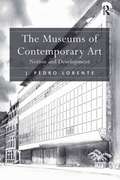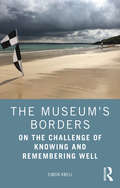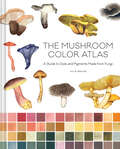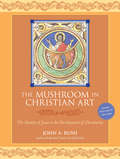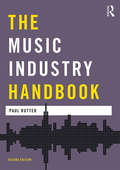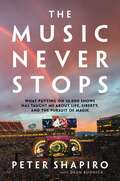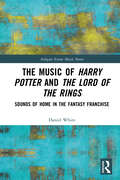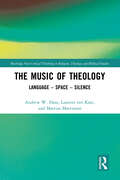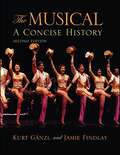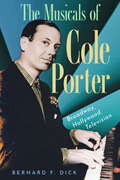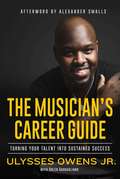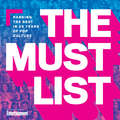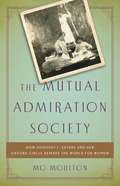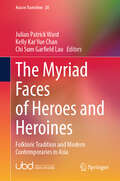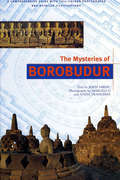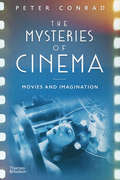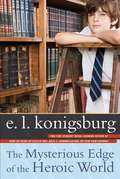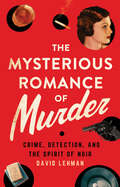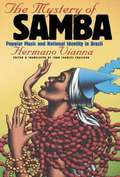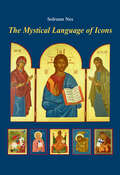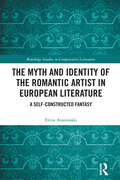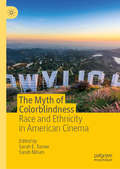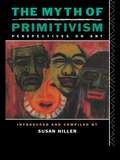- Table View
- List View
The Museums of Contemporary Art: Notion and Development (Routledge Revivals Ser.)
by J. Pedro LorenteWhere, how, by whom and for what were the first museums of contemporary art created? These are the key questions addressed by J. Pedro Lorente in this new book. In it he explores the concept and history of museums of contemporary art, and the shifting ways in which they have been imagined and presented. Following an introduction that sets out the historiography and considering questions of terminology, the first part of the book then examines the paradigm of the Musée des Artistes Vivants in Paris and its equivalents in the rest of Europe during the nineteenth century. The second part takes the story forward from 1930 to the present, presenting New York's Museum of Modern Art as a new universal role model that found emulators or 'contramodels' in the rest of the Western world during the twentieth century. An epilogue, reviews recent museum developments in the last decades. Through its adoption of a long-term, worldwide perspective, the book not only provides a narrative of the development of museums of contemporary art, but also sets this into its international perspective. By assessing the extent to which the great museum-capitals - Paris, London and New York in particular - created their own models of museum provision, as well as acknowledging the influence of such models elsewhere, the book uncovers fascinating perspectives on the practice of museum provision, and reveals how present cultural planning initiatives have often been shaped by historical uses.
The Museum’s Borders: On the Challenge of Knowing and Remembering Well
by Simon KnellThe Museum’s Borders demonstrates that museum practices are deeply entangled in border making, patrol, mitigation and erasure, and that the border lens offers a new tool for deconstructing and reconfiguring such practices. Arguing that the museum is a critical institution for the operation of knowledge-based democracies, Knell investigates how they have been used by scientists, art historians and historians to construct our bordered world. Examining the role of museums in the Windrush scandal in Britain, the exclusion of Black artists in America, ideological and propaganda discourses in Europe and China, and the remembering of contested pasts in the Balkans, Knell argues for the importance of museums in countering unethical, nationalistic, post-fact political discourse. Using the principles of Knell’s ‘Contemporary Museology’, The Museum’s Borders considers the significance of the museum for societies that wish to know and remember in ways that empower citizens and build cohesive societies. The book will be of great interest to students and academics engaged in the study of museums and heritage, art history, science studies, cultural studies, anthropology, memory studies and history. It is required reading for museum professionals seeking to adopt non-discriminatory practices.
The Mushroom Color Atlas: A Guide to Dyes and Pigments Made from Fungi
by Julie BeelerDiscover the chromatic wonders of the fungi kingdom and the incredible spectrum of pigments and dyes that can be created from mushrooms. "This stunning book is the result of years of creative experimentation. Mushrooms are chemical wizards, and Julie Beeler is a masterful guide to the spectrum of pigments they can make. I have spent many happy moments lost in the fungal colorscapes contained in this exquisitely produced volume." ―Merlin Sheldrake, author of Entangled LifeMore closely related to humans than they are to plants, fungi are fascinating organisms—and they are a rich resource for color collectors! Blending scientific detail, botanical illustrations, and creative inspiration, artist and educator Julie Beeler invites you to peek into her workroom as she introduces different types of dye mushrooms—from boletes to polypores to tooth fungi—and walks you through her color-harvesting process. Offering insightful tips on foraging and color distillation and a rainbow of color samples, Beeler peppers in down-to-earth advice on artistic experimentation and fascinating stories about the historical and personal connections between humans and nature, offering a fresh perspective on the magical world of mushrooms.UNIQUE FIELD GUIDE TO MUSHROOMS: This guide will take you on a vibrant journey through identifying and collecting dye mushrooms to distilling an astonishing range of colors from each one. The five hundred color swatches included in these pages showcase an astounding array of natural dyes and pigments made from mushrooms. A PRACTICAL AND INSPIRATIONAL GUIDE: The Mushroom Color Atlas combines step-by-step instructions for hands-on color creation with impressive hues and eye-catching palettes. Whether you're a working designer or an emerging artist, a full-time forager or an armchair mycologist, you will find something to love in this unique exploration of science and color. GO NATURAL: The rewarding hands-on experience of working with mushroom dyes and pigments is a powerful way to feel intimately connected to nature. Beeler invites readers to forge their own creative connection to the natural world, offering advice on ethical foraging, artistic experimentation, and the abundant possibilities afforded to us by the small but mighty mushroom.Perfect for: Mushroom enthusiasts, foragers, amateur mycologists, and nature lovers Artists; fashion, graphic, and interior designers; any professional who incorporates color into their work Crafters and creative hobbyists Color enthusiasts and people interested in natural dyes and pigments Anyone interested in sustainable fashion and textile arts
The Mushroom in Christian Art: The Identity of Jesus in the Development of Christianity
by John Rush Martin W. BallIn The Mushroom in Christian Art, author John A. Rush uses an artistic motif to define the nature of Christian art, establish the identity of Jesus, and expose the motive for his murder. Covering Christian art from 200 CE (common era) to the present, the author reveals that Jesus, the Teacher of Righteousness mentioned in the Dead Sea Scrolls, is a personification of the Holy Mushroom, Amanita muscaria. The mushroom, Rush argues, symbolizes numerous mind-altering substances—psychoactive mushrooms, cannabis, henbane, and mandrake—used by the early, more experimentally minded Christian sects.Drawing on primary historical sources, Rush traces the history—and face—of Jesus as being constructed and codified only after 325 CE. The author relates Jesus’s life to a mushroom typology, discovering its presence, disguised, in early Christian art. In the process, he reveals the ritual nature of the original Christian cults, rites, and rituals, including mushroom use. The book authoritatively uncovers Jesus’s message of peace, love, and spiritual growth and proposes his murder as a conspiracy by powerful reactionary forces who would replace that message with the oppressive religious-political system that endures to this day. Rush’s use of the mushroom motif as a springboard for challenging mainstream views of Western religious history is both provocative and persuasive.The package includes an informative DVD with 252 striking color images depicting Christian art, with key motifs indicated by the author.
The Music Industry Handbook (Media Practice)
by Paul RutterThe Music Industry Handbook, Second edition is an expert resource and guide for all those seeking an authoritative and user-friendly overview of the music industry today. The new edition includes coverage of the latest developments in music streaming, including new business models created by the streaming service sector. There is also expanded exploration of the music industry in different regions of the UK and in other areas of Europe, and coverage of new debates within the music industry, including the impact of copyright extensions on the UK music industry and the business protocols involved when music is used in film and advertising. The Music Industry Handbook, Second edition also includes: in-depth explorations of different elements of the music industry, including the live music sector, the recording industry and the classical music business analysis of business practices across all areas of the industry, including publishing, synchronisation and trading in the music industry profiles presenting interviews with key figures workings in the music industry detailed further reading for each chapter and a glossary of essential music industry terms.
The Music Never Stops: What Putting on 10,000 Shows Has Taught Me About Life, Liberty, and the Pursuit of Magic
by Peter ShapiroThe engrossing, insightful, and personal musical odyssey of Peter Shapiro, perhaps the most notable independent concert promoter since Bill Graham Peter Shapiro is the best known and most influential concert promoter of his generation. He owned the legendary Wetlands in Tribeca and has gone on to much bigger things, including Brooklyn Bowl (NYC, Las Vegas, Philadelphia, and Nashville), the Capitol Theatre in Port Chester, producing U2 3D, and promoting the Grateful Dead&’s fiftieth-anniversary tour (&“Fare Thee Well&”) featuring the Core Four and Trey Anastasio . . . and so much more. In The Music Never Stops, Shapiro shares the inside story of how he became a power-house in the music industry—an island in an increasingly consolidated landscape of venues, ticketing, and touring—through the lens of fifty iconic concerts. Along the way, readers gain insight into what it was like to work with some of the most celebrated bands in modern music, including not just the Grateful Dead and U2, but also Bob Dylan, Phish, Dave Matthews Band, Al Green, Ms. Lauryn Hill, Jason Isbell, Preservation Hall Jazz Band, The Roots, Robert Plant, Leonard Cohen, and many more. Featuring never-before-published back-stage anecdotes, insights, and photographs of the biggest bands in the business and the concerts that later became legendary, The Music Never Stops is a perfect guide for any-one who wants to understand the modern live music industry.
The Music of Harry Potter and The Lord of the Rings: Sounds of Home in the Fantasy Franchise (Ashgate Screen Music Series)
by Daniel WhiteThe Music of Harry Potter and The Lord of the Rings provides an in-depth study of the music of two of the biggest fantasy franchises, focussing on music’s worldbuilding roles within the film-watching experience and elsewhere in videogames, trailers, plays, theme parks and other attractions, and the world of fandom.Daniel White takes a range of approaches and techniques of motivic and thematic musical analysis, and pairs this with transformational harmonic analysis to theorise music’s worldbuilding roles in film. Chapters focus in turn on the opening sequences of the case study franchise films, their closing sequences, and on their depiction of houses, homes and homelands. Extra-filmic areas of these fantasy worlds are also explored, including theme parks and other tourist attractions of the Harry Potter franchise, videogames and the immersive power of their music, and the world of fandom with a focus on soundtrack consumption and other musical fan practices. Through this multifaceted approach, readers gain a deeper understanding not only of the music of these franchises, but also of music’s power in the multimedia franchise both within and without film to build a home that attracts inhabitants. This book will be valuable for academics and students as well as fans of fantasy franchises.
The Music of Theology: Language – Space – Silence (Routledge New Critical Thinking in Religion, Theology and Biblical Studies)
by Andrew Hass Mattias Martinson Laurens ten KateThis book reconceives theology as a musical endeavour in critical tension with language, space and silence. An Overture first moves us from music to religion, and then from theology back to music – a circularity that, drawing upon history, sociology, phenomenology, and philosophy, disclaims any theology of music and instead pursues the music in theology. The chapters that follow explore the three central themes by way of theory, music and myth: Adorno, Benjamin and Deleuze (language), Derrida, Rosa and Nancy (space), Schelling/Hegel, Homer and Cage (silence). In overdubbing each other, these chapters work towards theology as a sonorous rhythm between loss and freedom. A Coda provides three brief musical examples – Thomas Tallis, György Ligeti, and Evan Parker – as manifestations of this rhythm, to show in summary how music becomes the very pulse of theology, and theology the very intuition of music. The authors offer an interdisciplinary engagement addressing fundamental questions of the self and the other, of humanity and the divine, in a deconstruction of modern culture and of its bias towards the eye over the ear. The book harmonizes three scholarly voices who attempt to find where the resonance of our Western conceptions and practice, musically and theologically, might resound anew as a more expansive music of theology.
The Musical, Second Edition: A Concise History
by Kurt Gänzl Jamie FindlayThe Musical, Second Edition, introduces students and general readers to the entire scope of the history of musical theater, from eighteenth-century ballad operas to nineteenth-century operettas, to the Golden Age of Broadway to today. In this comprehensive history, master theater historian Kurt Gänzl draws on his vast knowledge of the productions, the actors, the music and dance, and the reception of the central repertory of the musical theater. Focus boxes on key shows are included in every chapter, along with a chronology of the major musical productions described in the text. Production photographs from around the world enhance the descriptions of the costumes and staging. This book is an ideal introduction for college-level courses on the History of Musical Theater and will also appeal to the general theatergoer who wants to learn more about how today’s musical developed from its earliest roots.
The Musicals of Cole Porter: Broadway, Hollywood, Television
by Bernard F. DickCole Porter (1891–1964) remains one of America’s most popular composer-songwriters, known for the many urbane, witty, romantic songs he wrote for stage musicals and Hollywood films. Porter was unique among his contemporaries for writing both the music and lyrics for his compositions. To this day, several of his numbers—“Night and Day,” “I’ve Got You Under My Skin,” “You’re the Top,” and “I Get a Kick Out of You,” to name a few—endure as standards. In The Musicals of Cole Porter: Broadway, Hollywood, Television, Bernard F. Dick presents a critical study of Porter’s Broadway and movie musicals, and his one foray into live television, Aladdin—covering the period from his first failure, See America First (1916), to the moderately successful Silk Stockings (1955), which ended his Broadway career. Taking a chronological approach, interspersed with chapters on Porter’s “list songs” that owe much to such operas as Mozart’s Don Giovanni and Rossini’s The Barber of Seville; his love songs, often bittersweet and bleakly poignant; and, above all, his love of figurative language, Dick discusses in detail the various literary sources and cultural reference points that inspired the lyrics to Porter’s numbers. The first volume of its kind exclusively dedicated to exploring the extensive body of work by this influential twentieth-century songwriter, The Musicals of Cole Porter is a compelling resource for readers interested in the craft of a great composer-lyricist.
The Musician's Career Guide: Turning Your Talent into Sustained Success
by Arlen Gargagliano Ulysses Owens JrAn Engaging and Accessible Guide to Achieving Sustained Access in the Music Industry As a musician, how can you blend art and survival and still keep loving the business? The Musician&’s Career Guide, written from the perspective of someone who has engaged in the daily struggle that all artists encounter, provides clear strategic support and advice in a knowledgeable, reader-friendly voice.From preparing for an audition to business planning to protecting one&’s mental and emotional well-being, The Musician&’s Career Guide marries practical tips with in-depth resources, anecdotes and stories to learn from, and comments for consideration and self-reflection. This book is a tool musicians can use to develop a realistic roadmap for success in the careers they desire. Part textbook, part self-directed learning tool, and full mentor, this information-packed text speaks with the voice of experience in a way that is realistic and attainable. The authors address topics including the following fundamental areas: Career development Touring Roles within the music industry Recording deals and industry PR and marketing for artists Keys to community engagement The mental side of being a musicianThe path and commitment to mastery as professional musician The Musician's Career Guide offers a foundation for both new and experienced musicians who yearn to clarify and achieve their individual goals of personal success and fulfillment through their craft. It's essential reading for any musician.
The Must List: Ranking the Best in 25 Years of Pop Culture
by The Editors of Entertainment WeeklyGet ready to obsess over the last twenty-five years of pop culture hits, misses, and cult classics. THE MUST LIST is an elegantly packaged, gift-worthy compilation of 100 top 25 lists celebrating the best in TV, movies, music, and books from the editors of Entertainment Weekly.Beginning with an introduction highlighting the "25 Things We've Forgotten About 1990", this full-color, illustrated deep-dive into the past twenty-five years of obsessive pop-culture coverage features the magazine's incisive criticism, trademark humor, and 2,500 amazing moments. Featured topics include: Greatest Villains, One-Hit Wonders, Best Superheroes, Mobsters, Zombies, Dystopias, Shocking Snubs, Unsexiest Sexy Moments, British Imports, Memorable Deaths, Late Night Comedy Wars, and many more binge-worthy lists.
The Mutual Admiration Society: How Dorothy L. Sayers and her Oxford Circle Remade the World for Women
by Mo MoultonA group biography of renowned crime novelist Dorothy L. Sayers and the Oxford women who stood at the vanguard of equal rights Dorothy L. Sayers is now famous for her Lord Peter Wimsey and Harriet Vane detective series, but she was equally well known during her life for an essay asking "Are Women Human?" Women's rights were expanding rapidly during Sayers's lifetime; she and her friends were some of the first women to receive degrees from Oxford. Yet, as historian Mo Moulton reveals, it was clear from the many professional and personal obstacles they faced that society was not ready to concede that women were indeed fully human. Dubbing themselves the Mutual Admiration Society, Sayers and her classmates remained lifelong friends and collaborators as they fought for a truly democratic culture that acknowledged their equal humanity. A celebration of feminism and female friendship, The Mutual Admiration Society offers crucial insight into Dorothy L. Sayers and her world.
The Myriad Faces of Heroes and Heroines: Folkloric Tradition and Modern Contemporaries in Asia (Asia in Transition #28)
by Kelly Kar Yue Chan Chi Sum Garfield Lau Julian Patrick WardThis collection scrutinizes the representation, dynamics, transformation and/or adaptation of various heroes and heroines in different folkloric traditions and narratives in the context of Asia. Exploring notions in the topics of mythologies, folktales, literature, theatre performance and any other art forms, the volume collates discussions on the pragmatic and aesthetic representation of men and women within the mythic world, and within contemporary settings. In doing so, it produces a contemporary theorization of Asian heroes and heroines beyond their mythic structure and folkloric limits. In considering the representation of heroes and heroines in the Asian folkloric tradition, and in comparative contexts, the book establishes connections between characters from myths and folktales and those found in contemporary narratives, considers the adaptation and transformation of heroes and heroines as revealed in a variety of literary works, and also assesses the gendering of social roles in modern literature and other art forms. It is of interest to scholars and advanced students in comparative literature, Asian cultural studies and theatre and performance.
The Mysteries of Borobudur
by John Miksic Marcello TranchiniThe Mysteries of Borobudur provides a comprehensive guide to the history and architecture of the monument in word and picture, with an informative text, complemented by colour photographs, maps, site plans and other visual materials
The Mysteries of Cinema: Movies And Imagination
by Peter ConradRanging from the late nineteenth century to the present day, this exhilarating survey by cultural critic Peter Conrad explores the ways film has changed how we see the world. This is a thematic roller-coaster ride through cinema history, with film expert Peter Conrad in the seat beside you. Thoroughly international, this book ranges from Fay Wray to Satyajit Ray, from Buster Keaton to Kurosawa, from westerns to nouvelle vague. Conrad explores the medium’s relationship to speed, technology, fantasy, horror, dream, color, sound, light, and shadow with reference to scores of films, from the earliest nineteenth-century silent experiments to the latest multisensory Hollywood blockbusters. The author’s insights are amplified by voices from inside and outside the industry: directors and critics are included alongside artists, writers, philosophers, and historians ranging from Leo Tolstoy to Salvador Dalí, Theodor Adorno to Philip Roth. Arranged by topics, such as “Meta-Movie” and “The Physics of Film,” rather than chronological events, The Mysteries of Cinema focuses on film’s otherworldly, hypnotic, and magical qualities. Perfect for both movie fans who will discover new films and directors, and for students of film who will see familiar classics in a new light, this volume is full of unique insights into the genre. Combining his vast knowledge with a forensic eye for a director’s every quirk and mannerism, Conrad offers a fascinating and thrilling exploration of film.
The Mysterious Edge of the Heroic World
by E. L. Konigsburg"ninety percent of who you are is invisible." Amedeo Kaplan seems just like any other new kid who has moved into the town of St. Malo, Florida, a navy town where new faces are the norm. But Amedeo has a secret, a dream: More than anything in the world, he wants to discover something -- a place, a process, even a fossil -- some treasure that no one realizes is there until he finds it. And he would also like to discover a true friend to share these things with. William Wilcox seems like an unlikely candidate for friendship: an aloof boy who is all edges and who owns silence the way other people own words. When Amedeo and William find themselves working together on a house sale for Amedeo's eccentric neighbor, Mrs. Zender, Amedeo has an inkling that both his wishes may come true. For Mrs. Zender's mansion is crammed with memorabilia of her long life, and there is a story to go with every piece. Soon the boys find themselves caught up in one particular story -- a story that links a sketch, a young boy's life, an old man's reminiscence, and a painful secret dating back to the outrages of Nazi Germany. It's a story that will take them to the edge of what they know about heroism and the mystery of the human heart. Two-time Newbery winner E. L. Konigsburg spins a magnificent tale of art, discovery, friendship, history, and truth.
The Mysterious Romance of Murder: Crime, Detection, and the Spirit of Noir
by David LehmanFrom Sherlock Holmes to Sam Spade; Nick and Nora Charles to Nero Wolfe and Archie Goodwin; Harry Lime to Gilda, Madeleine Elster, and other femmes fatales—crime and crime solving in fiction and film captivate us. Why do we keep returning to Agatha Christie's ingenious puzzles and Raymond Chandler's hard-boiled murder mysteries? What do spy thrillers teach us, and what accounts for the renewed popularity of morally ambiguous noirs? In The Mysterious Romance of Murder, the poet and critic David Lehman explores a wide variety of outstanding books and movies—some famous (The Maltese Falcon, Double Indemnity), some known mainly to aficionados—with style, wit, and passion.Lehman revisits the smoke-filled jazz clubs from the classic noir films of the 1940s, the iconic set pieces that defined Hitchcock's America, the interwar intrigue of Eric Ambler's best fictions, and the intensity of attraction between Humphrey Bogart and Lauren Bacall, Robert Mitchum and Jane Greer, Cary Grant and Ingrid Bergman. He also considers the evocative elements of noir—cigarettes, cocktails, wisecracks, and jazz standards—and offers five original noir poems (including a pantoum inspired by the 1944 film Laura) and ironic astrological profiles of Barbara Stanwyck, Marlene Dietrich, and Graham Greene. Written by a connoisseur with an uncanny feel for the language and mood of mystery, espionage, and noir, The Mysterious Romance of Murder will delight fans of the genre and newcomers alike.
The Mystery of Samba: Popular Music and National Identity in Brazil
by Hermano Vianna John C. ChasteenSamba is Brazil's "national rhythm," the foremost symbol of its culture and nationhood. To the outsider, samba and the famous pre-Lenten carnival of which it is the centerpiece seem to showcase the country's African heritage. Within Brazil, however, samba symbolizes the racial and cultural mixture that, since the 1930s, most Brazilians have come to believe defines their unique national identity. But how did Brazil become "the Kingdom of Samba" only a few decades after abolishing slavery in 1888? Typically, samba is represented as having changed spontaneously, mysteriously, from a "repressed" music of the marginal and impoverished to a national symbol cherished by all Brazilians. Here, however, Hermano Vianna shows that the nationalization of samba actually rested on a long history of relations between different social groups-poor and rich, weak and powerful-often working at cross-purposes to one another. A fascinating exploration of the "invention of tradition,"The Mystery of Sambais an excellent introduction to Brazil's ongoing conversation on race, popular culture, and national identity.
The Mystic Ark
by Conrad RudolphIn this book, Conrad Rudolph studies and reconstructs Hugh of St. Victor's forty-two-page written work, The Mystic Ark, which describes the medieval painting of the same name. In medieval written sources, works of art are not often referred to, let alone described in any detail. Almost completely ignored by art historians because of the immense difficulty of its text, Hugh of Saint Victor's Mystic Ark (c. 1125-1130) is among the most unusual sources we have for an understanding of medieval artistic culture. Depicting all time, all space, all matter, all human history, and all spiritual striving, this highly polemical painting deals with a series of cultural issues crucial in the education of society's elite during one of the great periods of intellectual change in Western history.
The Mystic Warriors of the Plains: The Culture, Arts, Crafts and Religion of the Plains Indians
by Thomas E. MailsThe mystic warriors of the plains is an indepth look at the history, customs, religeon, art work and dress of the American plains Indians. A look at the tribes that developed a civilization that rivals any of the ancient civilizations of the world.
The Mystical Language of Icons
by Solrunn NesThis lavishly illustrated guide to iconography explains through words and pictures the history, meaning, and purpose of Christian icons as well as the traditional methods that religious painters use to create these luminous, spiritually enlivened works of art. Solrunn Nes, one of Europe's most admired iconographers, illuminates the world of Christian icons, explaining the motifs, gestures, and colors common to these profound symbols of faith. Nes explores in depth a number of famous icons, including those of the Greater Feasts, the Mother of God, and a number of the better-known saints, enriching her discussion with references to Scripture, early Christian writings, and liturgy. She also leads readers through the process and techniques of icon painting, showing each step with photographs, and includes more than fifty of her own original works of art. Deeply inspiring and utterly unique, The Mystical Language of Icons will inform both those who are familiar with the rich tradition of religious art and those who are not. It also serves as a powerful devotional resource in its own right, one that Christians everywhere can turn to again and again.
The Myth and Identity of the Romantic Artist in European Literature: A Self-Constructed Fantasy (Routledge Studies in Comparative Literature)
by Elena AnastasakiThis study addresses the question of artistic identity and the myth of the artist as it has been shaped by the artists themselves. While the term artist is to be understood in a broad sense, the focus of this study is the literature of the Romantic tradition. Identity is largely perceived as a construct, and a central hypothesis of this book concerns its aesthetic value and the ways it creates dominant narratives of self-perception that produce powerful myths. The construction of the artist’s identity, be it collective or personal, rests on a series of aesthetic praxes. Caught between the mythic idealisation of poetic genius and its social devaluation, the Romantic artist seeks to create a place for himself, and in doing so, he engages in his own mythmaking. This process is studied in an interdisciplinary perspective, approaching texts and writers from different traditions. The study analyses various typologies of the artist, numerous mythmaking strategies as well as several postural techniques; all of which have sketched major direct or indirect fictional self-portraits in the European tradition.
The Myth of Colorblindness: Race and Ethnicity in American Cinema
by Sarah E. Turner Sarah NilsenThis book explores representations of race and ethnicity in contemporary cinema and the ways in which these depictions all too often promulgate an important racial ideology: the myth of colorblindness. Colorblindness is a discursive framework employed by mainstream, neoliberal media to celebrate a multicultural society while simultaneously disregarding its systemic and institutionalized racism. This collection is unique in its examination of such films as Ex Machina, The Lone Ranger, The Blind Side, Zootopia, The Fast and the Furious franchise, and Dope, which celebrate the myth of colorblindness, yet perpetuate and entrench the racism and racial inequities that persist in contemporary society. While the #OscarsSoWhite movement has been essential to bringing about structural changes to media industries and offers the opportunity for a wide diversity of voices to alter and transform the dominant, colorblind narratives continue to proliferate. As this book demonstrates, Hollywood still has a long way to go.
The Myth of Primitivism
by Susan HillerThis book explores the fusion of myth, history and geography which leads to ideas of primitivism, and looks at their construction, interpretation and consumption in Western culture. Contextualized by Susan Hiller's introductions to each section, discussions range from the origins of cultural colonialism to eurocentric ideas of primitive societies, including the use of primitive culture in constructing national identities, and the appropriation of primitivist imagery in modernist art. The result is a controversial critique of art theory, practice and politics, and a major enquiry into the history of primitivism and its implications for contemporary culture.
